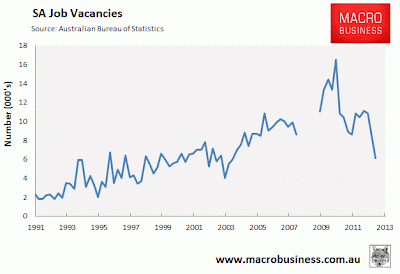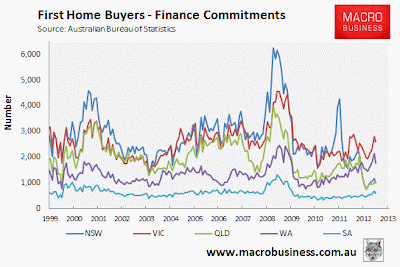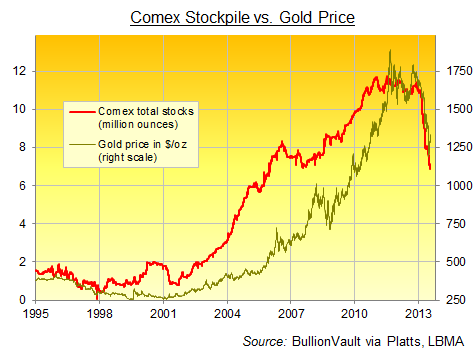Long term readers of the blog would be aware that my opinion of Australian property is that it represents poor value at today's prices (relative to historical norms measured against rent and incomes). My medium term expectations for property led to the sale of my (Adelaide) home in early 2010. The property was purchased with intent to live in it for a few years and then later develop it, but wanting a change of scenery my wife and I were presented with the choice to move and then rent it out (hold for investment / future development) or sell it, we chose the latter and have since rented for the past 3.5 years (with lease recently negotiated through mid 2014). We have no regrets.
Adelaide house prices have been falling since a few months after we sold and are still tracking below their 2010 peak while rental price increases have been minimal. While renting is suitable and preferable in my situation, I would never discourage others who want the stability of ownership and are prepared to treat housing as a consumable (rather than an investment) from buying. If you have a healthy deposit (preferably one that will help you avoid LMI), fixed interest rate (or able to service higher interest rates), protect yourself (income protection, cash buffer, etc) and expect to stay in the property you purchase for the long term (until mortgage paid off), then it shouldn't matter what prices do (rise, fall or stagnate).
Some people are happy to pay a premium for the stability and enjoyment they get from home ownership, perhaps down the track when starting a family my priorities will change and I will make the same decision. For now I will continue renting, it is far cheaper than the interest repayments would be for a mortgage if buying the equivalent, it provides more flexibility and there is a good chance that my housing requirements will change at some point in the next few years (so it's pointless buying now if I will only be looking to upgrade in a few years).
Some people are happy to pay a premium for the stability and enjoyment they get from home ownership, perhaps down the track when starting a family my priorities will change and I will make the same decision. For now I will continue renting, it is far cheaper than the interest repayments would be for a mortgage if buying the equivalent, it provides more flexibility and there is a good chance that my housing requirements will change at some point in the next few years (so it's pointless buying now if I will only be looking to upgrade in a few years).
From an investment point of view I think 'buy and hold' property will continue to be a poor investment choice for a majority over the medium term (3-5 years). Of course there will always be cities, suburbs or even specific deals which can buck the trend as the exception and exceptional people who can turn a dollar in the property market no matter what the 'median' is doing. It may not be beneficial for long term investors to sell (given high transaction costs for property), but any investors looking to buy in today's market would do well to ensure they understand the risks that Australia's property market faces as we unwind from the resources boom. It is highly unlikely that the next 15 years will replicate the property price growth we have seen over the last 15.
Last year on the blog I covered the conditions and my expectations for the Melbourne and Perth property markets.
Melbourne has surprised me having bounced strongly from the mid 2012 lows, still around 4% below the peak, but 8% higher than the lows (as measured by RP Data's daily price index). Many of the data points (high stock on market, poor yields, low number of transfers) that led to my expectation of a further decline in Melbourne prices remain in place. It's my expectation that the Melbourne price rally is a dead cat bounce driven by falling interest rates and that lower prices will be seen in the future (lower nominal prices than the mid 2012 "bottom"). I still think there is a chance of a 30-40% decline in prices in real terms, perhaps it plays out over a long time frame than I expected or perhaps I will be wrong. One thing is for sure, Melbourne property represents very poor value for money if purchasing for yield, but markets can remain irrational for long periods of time, especially when tax laws are favourable for those speculating on higher prices.
Perth has followed my expected trajectory with prices growing strongly (to the surprise of some). Flat prices for 6 years, rents growing strongly, healthy employment statistics and with the added support of falling interest rates resulted in a large push higher for prices over the last 12 months. While I think prices in Perth could continue rising into the end of the year and maybe even into next year, the strong fundamentals are already starting to wane with unemployment rising, rental prices stalling and increasing vacancy rates. The end of the mining capex boom could have implications for Perth property prices, as I wrote in the comments under last years article, "I think there is good potential for prices short term, but with the eventual commodity bust I think we will see prices in Perth reverse again, perhaps even to lower levels than today (e.g. could grow by 15% over 2 years and then fall by 20% following)." In other words I expected strong growth, but think there is a risk this growth reverses as Perth fundamentals turn south with the end of the resources boom.
So that brings me to the question in the title, what do I expect to see from Adelaide prices over the short to medium term?
Here is a quick overview of some data points that may have an effect on the Adelaide housing market...
Stock on market (SQM Research) is still at elevated levels reminiscent of during the GFC, they have remained elevated for the past 3 years, during which time we've seen prices decline. Although the last few months show a reduction in the stock on market, we have seen similar seasonal declines in the middle months of 2011 & 2012 (who wants to venture out to open homes during our cold winters!), which makes me think we could see similar this year with a rise in stock seeming likely into October/November.
Vacancy rates (SQM Research), although not as high as the worst of the GFC, are also elevated around the same levels we've seen over the last 3 years as prices declined:
Yields for Adelaide property remains low (sourced from Residex) with houses at 4.69% (below national average) and 5.19% for units (same as national average). Even with mortgage interest rates coming down these yields don't do much to wet the appetite given the risk of further price falls. Asking rents haven't increased in Adelaide over the last 12 months according to APM's June rental report.
Here is a quick overview of some data points that may have an effect on the Adelaide housing market...
Stock on market (SQM Research) is still at elevated levels reminiscent of during the GFC, they have remained elevated for the past 3 years, during which time we've seen prices decline. Although the last few months show a reduction in the stock on market, we have seen similar seasonal declines in the middle months of 2011 & 2012 (who wants to venture out to open homes during our cold winters!), which makes me think we could see similar this year with a rise in stock seeming likely into October/November.
Vacancy rates (SQM Research), although not as high as the worst of the GFC, are also elevated around the same levels we've seen over the last 3 years as prices declined:
Yields for Adelaide property remains low (sourced from Residex) with houses at 4.69% (below national average) and 5.19% for units (same as national average). Even with mortgage interest rates coming down these yields don't do much to wet the appetite given the risk of further price falls. Asking rents haven't increased in Adelaide over the last 12 months according to APM's June rental report.
While other states experienced a noticeable pickup in the population growth rate (MacroBusiness) into the end of 2012, Adelaide was the exception, even showing signs of rolling over to the downside (statistics for first half of this year are due late September):
South Australian unemployment (via Mark the Graph) is on the rise with an unusually large spike in the last months data, this may prove to be an anomaly, but the trend from early 2012 is still ugly:
Only Tasmania has a higher unemployment rate than South Australia now:
And with job vacancies back to levels not seen in a decade, it doesn't look like this unemployment rate is about to get better anytime soon (MacroBusiness):
With poor unemployment figures it's not surprising to see that retail appears to be doing poorly in and around Adelaide with the latest report from Herron Todd White discussing Rundle Mall (CBD) vacancies:
Only Tasmania has a higher unemployment rate than South Australia now:
And with job vacancies back to levels not seen in a decade, it doesn't look like this unemployment rate is about to get better anytime soon (MacroBusiness):
With poor unemployment figures it's not surprising to see that retail appears to be doing poorly in and around Adelaide with the latest report from Herron Todd White discussing Rundle Mall (CBD) vacancies:
"There are still concerns in the Mall with several large tenancies still remaining vacant."Further on the CBD:
"Few sales have been recorded this year, however we expect yields at best should remain stable given that rents have softened. Capital values within the CBD overall may therefore have weakened during the first half of 2013. It remains to be seen whether once the redevelopment works are completed in 2014 if there will be stronger overall retail activity in the Mall Precinct."Glenelg (Adelaide's popular beach side suburb) not doing much better:
"While vacancy rates are still low in this precinct they are ever present and increasing with few new leasing’s evident this year. This is far cry from a decade ago where there was virtually full occupancy along Jetty Road."King William Road and the Parade (located inner suburbs) sound similar:
"Similarly, King William Road is experiencing some weakness in new leasing activity although part of this is due to some speculative developments and part due to the general weakening of retail conditions. The Parade at Norwood retail sector is generally remaining quite strong although there are some signs of weakening conditions and some vacancies."The report finishes on this sour note:
"The overall outlook for retail is for subdued activity with the possibility of increasing vacancies and softer rentals for many centres. The trading conditions for tenants are heavily dependent on the economy which is showing further signs of deterioration."Other commercial real estate is also showing weakness with the office vacancy rate having risen from 9.5% to 12.1% over the last 6 months in Adelaide (Property Council of Australia), not really surprising given the rising level of unemployment:
The residential construction sector is also looking unhealthy with dwelling completions having trended lower the past couple of years (MacroBusiness):
And approvals off the lows, but still very subdued (3-month moving average via MacroBusiness):
First Home Buyer finance commitments have ticked up toward the middle of this year (but remain subdued relative to levels seen in the past):
Dwelling approvals and first home buyer commitments have likely seen their small increase in numbers due to the states Housing Construction Grant (which has now been extended through to the end of this year):
CASH payments of $8500 for people building homes will be extended until the end of the year to stimulate the construction industry.If the Housing Construction Grant (ending December 2013) and First Home Owners Grant for established homes (ending mid 2014) wind up as scheduled, then we could see downward pressure on Adelaide house prices as a result of this stimulus removal.
Premier Jay Weatherill will commit $38.7 million in the State Budget to retain the Housing Construction Grant.
It was first announced last October and was due to expire on June 30. Mr Weatherill said offering the grant for longer would help remove barriers to home ownership and stimulate the construction sector.
More than 1100 people have received the grant in the seven months since it was introduced. Adelaide Now
Weakness in the South Australian economy has not gone unnoticed with a recent article in the AFR highlighting a report from the SA Centre for Economic Studies:
The Economic Briefing Report found real state final demand decreased by 2.6 per cent from the previous year, which was the largest annual SFD fall in the period covered by the modern National Accounts data.Like most of the country, Adelaide house prices have seen a significant rise over the last couple of decades resulting in prices which are out of reach for many, the following from Bob Beaumont (of Adelaide based Beaumont Tiles):
Centre for Economic Studies executive director Michael O’Neil said this “sustained decline” indicated the state was in recession…
The state has come under enormous financial pressure over the last year with the government forced to grapple a bulging public sector wage bill, revenue writedowns and the loss of BHP’s $25 billion Olympic Dam expansion project.
Confidence is also low in the state’s manufacturing sector with the future of car maker Holden’s Elizabeth factory in doubt.
Australian house prices have increased 150 per cent in a decade, while incomes have grown by just under 60 per cent. In 2013 in Adelaide, the median house price is now more than six times the median income.
Since its inception in 1973, the South Australian Land Commission has watched land prices rise from $15,000 per block (in current dollars) to $160,000 per block. By comparison, the cost of building a 135sq m house increased from $97,000 in current dollars to just $102,000 over the same period. The Australian
However, Adelaide's house price index as measured by the ABS shows a sideways to lower market over the last 3.5 years and in my opinion the poor economic fundamentals for the state as outlined above point to further price weakness ahead:
Both Sydney and Perth have experienced 5-6 year sideways markets (as discussed in my article on Perth) at different times within the last decade and that is the sort of scenario I could see playing out in Adelaide, that would mean little to no price growth over the next 2-3 years.
Adelaide has a history of moderate price changes when compared with the likes of Perth or Melbourne and I think the future will be no different. I don't expect a massive bust in Adelaide real estate, but I think that prices are likely to continue tracking sideways or lower for some years to come, meaning that those saving for a deposit should feel comfortable the market is not likely runaway from them quickly, at least not until we see a significant pickup in the economic fundamentals for the city and state.
Adelaide has a history of moderate price changes when compared with the likes of Perth or Melbourne and I think the future will be no different. I don't expect a massive bust in Adelaide real estate, but I think that prices are likely to continue tracking sideways or lower for some years to come, meaning that those saving for a deposit should feel comfortable the market is not likely runaway from them quickly, at least not until we see a significant pickup in the economic fundamentals for the city and state.
You can follow me on Twitter. I'm usually sharing links and opinions daily (@BullionBaron). You can also CLICK HERE to signup for free email updates.
BB.





-for-Jul-2013.png)











